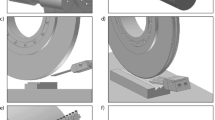Abstract
Grinding fluid is commonly applied to control grinding defects caused by high grinding zone temperature. Delivery of fluid to the grinding zone is obstructed by the formation of a stiff air layer around the grinding wheel. This results in huge wastage of grinding fluid. In the present paper, results of using a pneumatic barrier and a compound nozzle are discussed with respect to delivering fluid deep into the grinding zone. Grinding fluid passing through the grinding wheel contact zone is measured under different modes of fluid delivery using a flood cooling, or a compound, nozzle, with or without the application of a pneumatic barrier. It is found that the system using a pneumatic barrier with flood cooling nozzle, and that employing a compound nozzle perform better than the flood cooling nozzle. A compound nozzle along with a pneumatic barrier renders substantially less wastage of grinding fluid even at a low flow rate of grinding fluid. Above a fluid discharge of 475 ml/min, the compound nozzle alone shows effective penetration of grinding fluid through the grinding zone. Reduction of grinding force, specific energy and roughness of ground surface are obtained after using compound nozzle fluid delivery system. Compound nozzle may be used instead of flood cooling nozzle as it improves grinding performance even using 52.5 % less discharge of grinding fluid.










Similar content being viewed by others
References
Malkin S (1989) Grinding technology: theory and application of machining with abrasives. Ellis Harwood Publication, UK
Rowe WB (2009) Principles of modern grinding technology, 1st edn. Elsevier, UK
Shibata J, Goto T, Yamamoto M (1982) Characteristics of air flow around a grinding wheel and their availability for assessing the wheel wear. Ann CIRP 31(1):233–238
Davies TP, Jackson RG (1981) Air flow around grinding wheels. Precis Eng 3(2):225–228
Ebbrell S, Woolley NH, Tridimas YD, Allanson DR, Rowe WB (2000) The effect of cutting fluid application methods on the grinding process. Int J Mach Tools Manuf 40:209–223
Brinksmeier E, Heinzel C, Wittmann M (1999) Friction, cooling and lubrication in grinding. Ann CIRP 48(2):581–598
Wu H, Lin B, Cai R, Morgan MN (2007) Measurement of the air boundary layer on the periphery of a rotating grinding wheel using LDA. J Phys: Conf Ser 76(012059):1–6
Mandal B, Singh R, Das S, Banerjee S (2010) Study of the behavior of air flow around a grinding wheel under the application of pneumatic barrier. In: Proceedings of the 36th international MATADOR conference, Manchester, UK, pp 113–116
Mandal B, Majumder S, Das S, Banerjee S (2010) Predictive modeling and investigation on the formation of stiff air-layer around the grinding wheel. Adv Mater Res 83–86:654–659
Mandal B, Majumder S, Das S, Banerjee S (2011) Formation of a significantly less stiff air-layer around a grinding wheel pasted with rexine leather. Int J Precis Technol 2(1):12–20
Engineer F, Guo C, Malkin S (1992) Experimental measurement of fluid flow through the grinding zone. Trans ASME J Eng Ind 114:61–66
Sarmacharya RS, George MN, Das S (1998) On the grinding wheel performance through minor wheel modification. In: Proceedings of the 18th AIMTDR conference, Kharagpur, India, pp 156–161
Das S, Sharma AO, Singh SS, Nahate SV (2000) Grinding performance through effective application of grinding fluid. Proceedings of the international conference on manufacturing, Dhaka, Bangladesh, pp 231–239
Irani RA, Bauer RJ, Warkentin A (2005) A review of cutting fluid application in the grinding process. Int J Mach Tools Manuf 45:1696–1705
Webster JA (2007) Improving surface integrity and economics of grinding by optimum coolant application, with consideration of abrasive tool and process regime. Proc IMechE Part B: J Eng Manuf 221:1665–1675
Mandal B, Biswas D, Sarkar A, Das S, Banerjee S (2013) Improving grindability of Inconel 600 using alumina wheel through pneumatic barrier assisted fluid application. Adv Mater Res 622–623:394–398
Mandal B, Biswas D, Sarkar A, Das S, Banerjee S (2013) Grinding performance using a compound nozzle characterised by small discharge of fluid. J Assoc Eng India 83(1):28–35
Banerjee S, Ghosal S, Dutta T (2008) Development of simple technique for improving the efficacy of fluid flow through the grinding zone. J Mater Process Technol 197(1–3):306–313
Morgan MN, Jackson AR, Wu H, Baines-Jones V, Batako A, Rowe WB (2008) Optimisation of fluid application in grinding. CIRP Ann-Manuf Technol 57:363–366
Aurich JC, Kirsch B, Herzenstiel P, Kugel P (2011) Hydraulic design of a grinding wheel with an internal cooling lubricant supply. Prod Eng Res Dev 5(2):119–126
Mandal B, Singh R, Das S, Banerjee S (2011) Improving grinding performance by controlling air flow around a grinding wheel. Int J Mach Tools Manuf 51:670–676
Mandal B, Singh R, Das S, Banerjee S (2012) Development of a grinding fluid delivery technique and its performance evaluation. Mater Manuf Process 27(4):436–442
Mandal B, Das GC, Das S, Banerjee S (2010) Development of a grinding fluid delivery technique. In: Proceedings of the 3rd international and 24th AIMTDR conference, Visakhapatnam, India, pp 897–901
Hadad MJ, Tawakoli T, Sadeghi MH, Sadeghi B (2012) Temperature and energy partition in minimum quantity lubrication-MQL grinding process. Int J Mach Tools Manuf 54–55:10–17
Li KM, Lin CP (2012) Study on minimum quantity lubrication in micro-grinding. Int J Adv Manuf Technol 62(1–4):99–105
Mao C, Tang X, Zou H, Zhou ZX, Yin W (2012) Experimental investigation of surface quality for minimum quantity oil–water lubrication grinding. Int J Adv Manuf Technol 59(1–4):93–100
Morgan MN, Barczak L, Batako A (2012) Temperatures in fine grinding with minimum quantity lubrication (MQL). Int J Adv Manuf Technol 60(9–12):951–958
Author information
Authors and Affiliations
Corresponding author
Rights and permissions
About this article
Cite this article
Mandal, B., Das, G.C., Das, S. et al. Improving grinding fluid delivery using pneumatic barrier and compound nozzle. Prod. Eng. Res. Devel. 8, 187–193 (2014). https://doi.org/10.1007/s11740-013-0507-x
Received:
Accepted:
Published:
Issue Date:
DOI: https://doi.org/10.1007/s11740-013-0507-x




